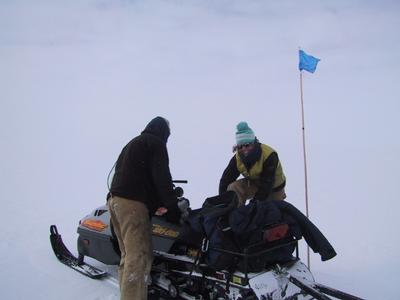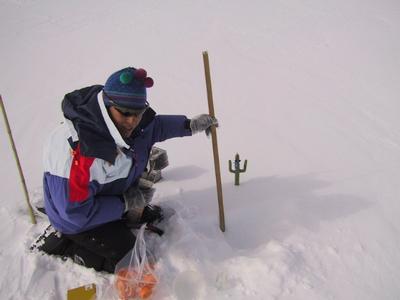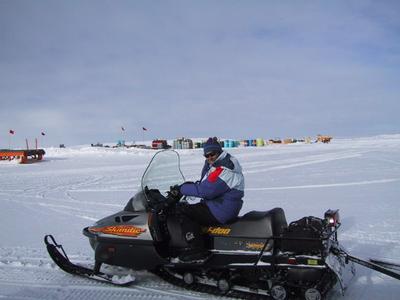
|
23 July, 2001Tracking Snow Accumulation One thing I really like about this place is it’s never dull. There are many interesting things happening every day. Even without the added challenge of the snow, wind and cold, the work here is intriguing. This morning brought the improvement in weather we all had been hoping for after yesterday’s challenges. Everyone was ready for a relief from the wind and cold. The mood around camp was definitely more upbeat than it was twenty four hours ago. Unfortunately, the linear detector went berserk again yesterday afternoon. That’ s the one I use in the lab to detect HCHO (formaldehyde) in the snow. So although I cannot analyze any of my snow samples right now, Markus and I have decided I will continue snow sampling in yesterday’s fresh fallen snow. After we discussed the situation, I gathered up my snow bottles and other tools and headed out to the sample area. I collected a set of 20 bottles of snow from a 30 centimeter deep pit. I also collected surface snow in three different areas across a sastrugi. Later, I returned to the same area and collected more snow so that we could look at the changes throughout the day and so that we could compare freshly fallen snow to older snow, 30 centimeters below the surface. The deep snow has been there anywhere from 6 months to a year. Now how do we know that fact? I discovered the answer during my next afternoon excursion today. While Shelly with help from Rod, replaced the lamp in the HCHO detector, I went along with Mark, Kathy and Meg to raise and measure the snow accumulation poles. These poles, made of bamboo, are placed in a zig- zag formation extending eleven kilometers away from camp. For this journey, we loaded up two snowmobiles with measuring tools, emergency survival gear and hot- cocoa. Once loaded we headed out into the great white yonder. At each of the 122 poles, Meg measured the snow depth that has fallen this month and recorded it in a little book. Then Kathy, Mark and I pulled the poles up to a height of 150 centimeters and re-flagged them. The poles will continue to be measured monthly by the winter-over crew. We stopped for hot cocoa along the way. The whole process took about four hours. I enjoyed the chance to see some new territory, even if it was just all white like the rest of the place. The average accumulation of snow in this area is seventy three centimeters a year. This study has been going on for five years. The data we collected today, is just one of the sixty one times this area has been measured. It felt good to be part of a long term - low technology project. While I was out snowmobiling, Shelly and Rod replaced the lamp in the detector, so after dinner tonight I was able to return to the analysis of today’s snow. It is fun to collect the snow and analyze it on the same day. Today, I was able to see first hand how fresh snow has much higher concentrations of H202 and HCHO than the older, deeper snow. Markus has finally gotten his instrument gremlins and ghosts under control. Now on our seventh day here, everything is running so we may be able to begin even more experiments tomorrow. As soon as I am finished here, I have to return again to my petri dishes and begin again. Markus tells me that since the air is still we should see some sublimation tonight. So, I am about to head out and reload the dishes for the fourth time. (I am beginning to suspect that the other scientists have given me this project as a practical joke to see how many times I’ll start over when the dishes drift back in. They all look so sincere when they ask how its going. If they are teasing me they are very convincing. Stay tuned....) To learn more about the sublimation experiment see parallel experiments
Contact the TEA in the field at . If you cannot connect through your browser, copy the TEA's e-mail address in the "To:" line of your favorite e-mail package. |







